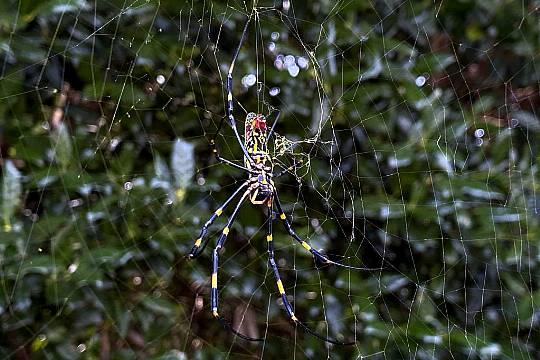A large spider native to East Asia has spun its thick, golden web on power lines, porches and vegetable patches all over north Georgia in the US this year.
This proliferation has driven some unnerved homeowners indoors and prompted a flood of anxious social media posts.
In metro Atlanta, Jennifer Turpin — a self-described arachnophobe — stopped blowing leaves in her yard after inadvertently walking into a web created by the Joro spider. Stephen Carter has avoided a walking trail along the Chattahoochee River where he encountered Joro webs every dozen steps.
Farther east in Winterville, Georgia, Will Hudson’s front porch became unusable amid an abundance of Joro webs 10 feet deep. Hudson estimates he has killed more than 300 of the spiders on his property.
“The webs are a real mess,” said Hudson, an entomologist at the University of Georgia. “Nobody wants to come out of the door in the morning, walk down the steps and get a face full of spider web.”

The Joro — Trichonephila clavata — is part of a group of spiders known as orb weavers for their highly organised, wheel-shaped webs.
Common in Japan, China, Korea and Taiwan, Joro females have colourful yellow, blue and red markings on their bodies. They can measure three inches across when their legs are fully extended.
It’s not clear how and when the first Joro spider arrived in the US. In Georgia, a researcher identified one about 80 miles northeast of Atlanta in 2014.
They have also been found in South Carolina, and Hudson is convinced they will spread across the South.
It’s also not clear why they are so abundant this year, although experts do agree their numbers have exploded.
“We see natural ebbs and flows in the populations of many different species that may be linked to local conditions, particularly slight changes in rainfall,” said Paula Cushing, an arachnologist at the Denver Museum of Nature & Science.
Cushing and other experts say Joros are not a threat to humans or dogs and cats and will not bite unless they are feeling very threatened. Hudson said a researcher collecting them with her bare hands reported the occasional pinch, but said the spiders never broke her skin.
Researchers, however, don’t agree on what impact, if any, the spider will have on other species and the environment.
Debbie Gilbert, 67, isn’t waiting to find out. She has adopted a zero-tolerance policy for the spiders around her home in Norcross, Georgia, winding their webs with a stick, bringing them down and stomping them.
“I don’t advocate killing anything. I live in peace with all the spiders around here and everything else,” she said. “But (Joros) just don’t belong here, that’s all.”
Nancy Hinkle, another entomologist at the University of Georgia, said Joros help suppress mosquitoes and biting flies and are one of the few spiders that will catch and eat brown marmorated stink bugs, which are serious pests to many crops.
“This is wonderful. This is exciting. Spiders are our friends,” she said. “They are out there catching all the pests we don’t want around our home.”







